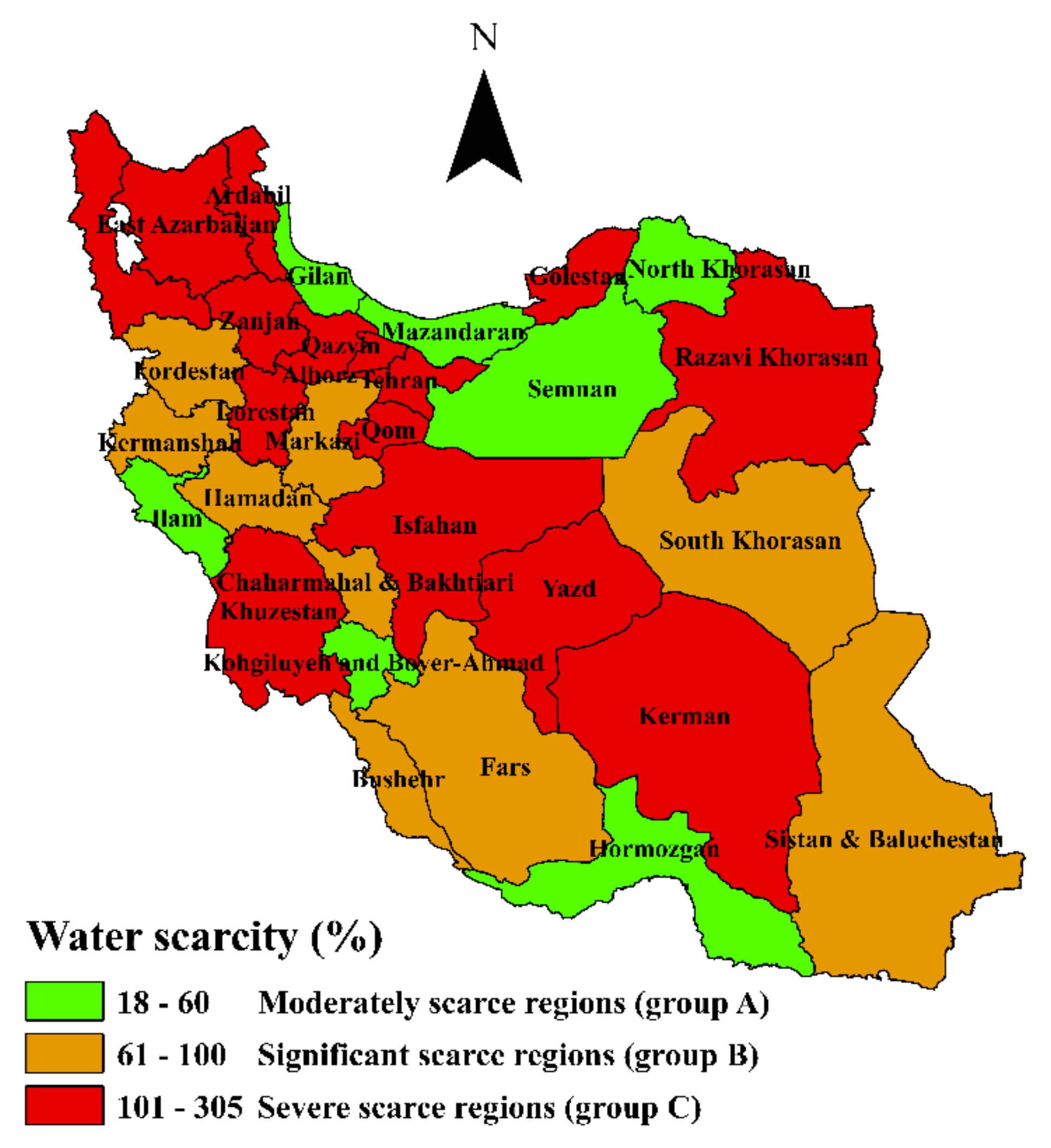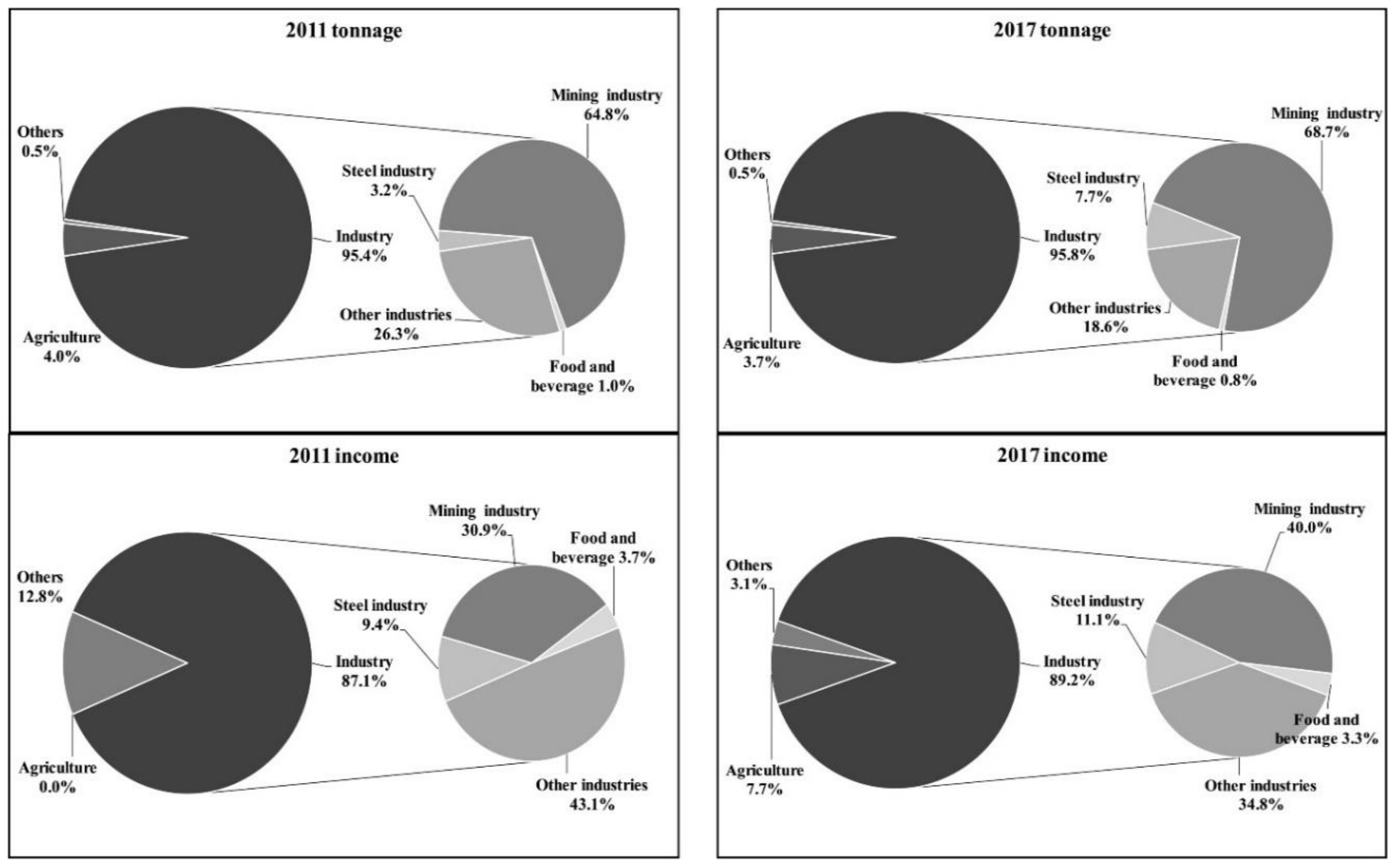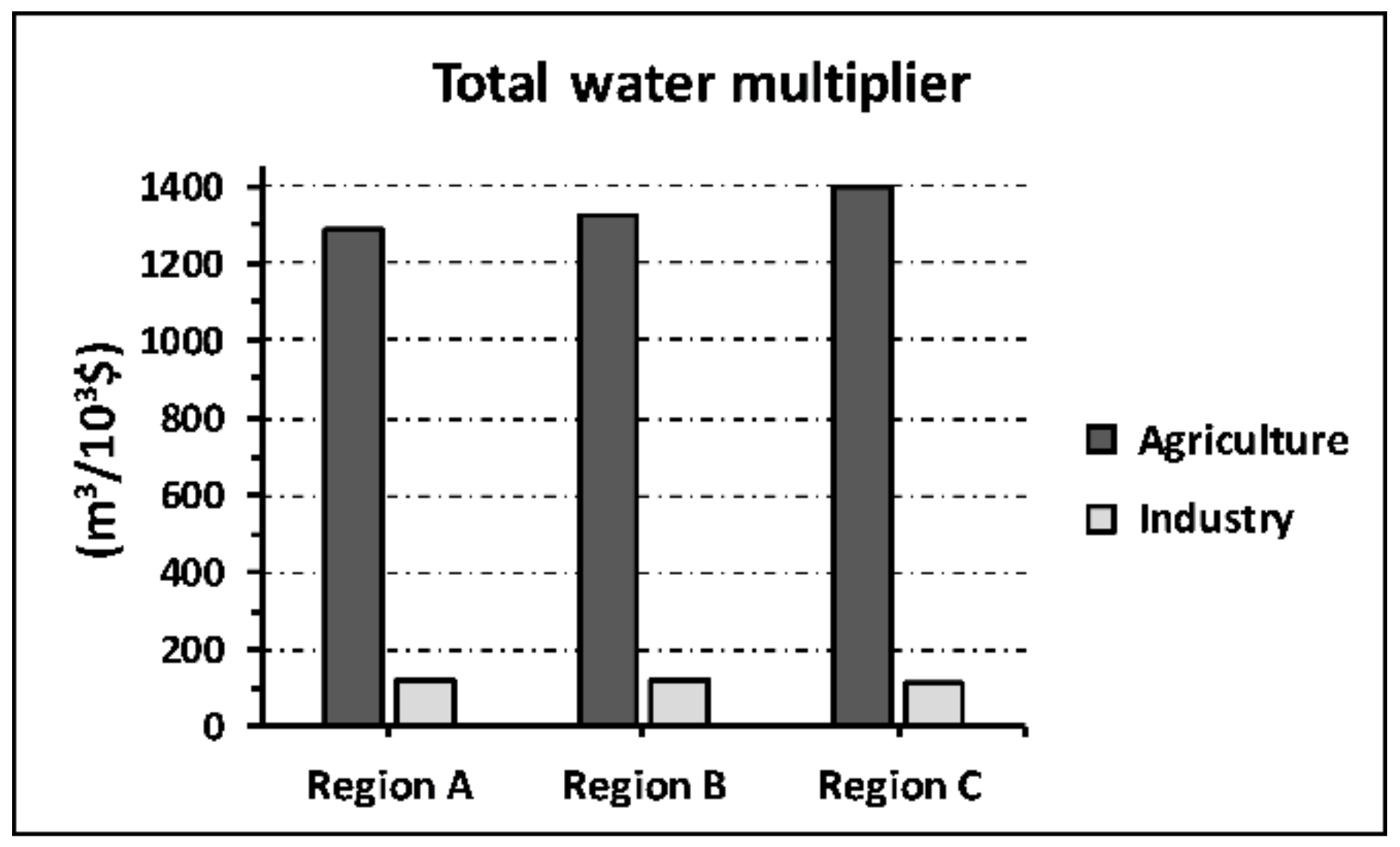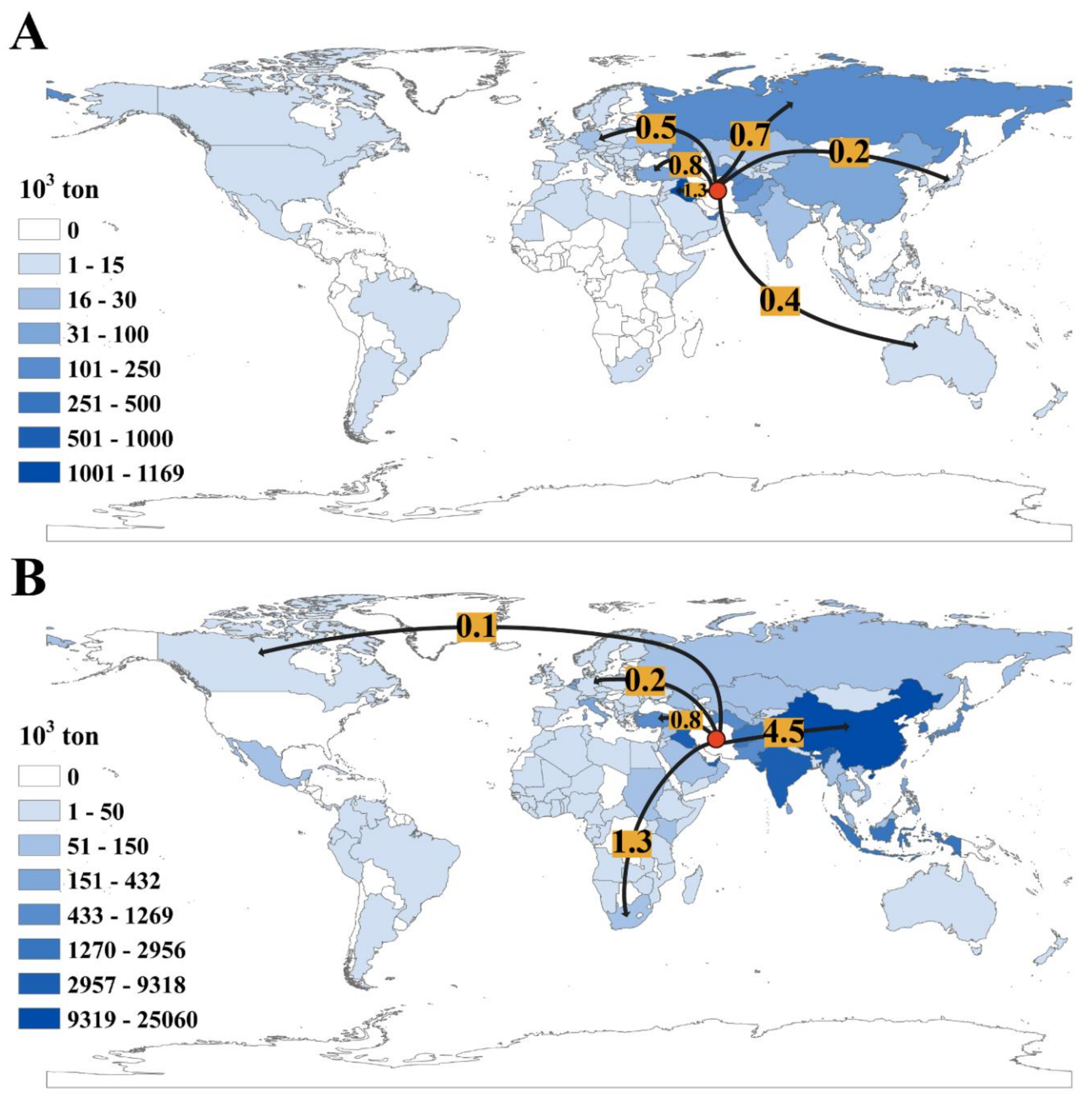Assessment of Virtual Water Flows in Iran Using a Multi-Regional Input-Output Analysis
Abstract
1. Introduction
2. Materials and Methods
2.1. Multiregional IO (MRIO) Model
2.2. Data
2.2.1. Economic Data to Construct the MRIO Table
2.2.2. Water Availability Data
3. Results
3.1. Virtual Water Trade of Regions
3.2. Water Footprint of Regions and Sectors
4. Discussion and Limitations of the Study
4.1. Virtual Water Trade and Water Footprint
4.2. Major Destinations of Exports and Water-Intensive Trade Structure
4.3. Limitations of the Study
5. Conclusions
Author Contributions
Funding
Acknowledgments
Conflicts of Interest
Appendix A
| Output/Input | Intermediate Demand | Final Demand | Total Demand | ||||
|---|---|---|---|---|---|---|---|
| A | B | C | Internal Final Demand | Final and Capital Exports to Inside the Country | Exports to Outside the Country | ||
| A | |||||||
| B | |||||||
| C | |||||||
| Value Added | |||||||
| Intermediate Output | |||||||
| Final and Capital Imports from Inside the Country | |||||||
| Imports from Outside the Country | |||||||
| Total Supply | |||||||
References
- Ashraf, B.; Yazdani, R.; Mousavi-Baygi, M.; Bannayan, M. Investigation of temporal and spatial climate variability and aridity of Iran. Theor. Appl. Climatol. 2014, 118, 35–46. [Google Scholar] [CrossRef]
- Mehta, L. Whose scarcity? Whose property? The case of water in western India. Land Use Policy 2007, 24, 654–663. [Google Scholar] [CrossRef]
- Lehane, S. The Iranian Water Crisis; Strategic Analysis Paper; Future Direction International Pty Ltd.: Nedlands, Ustralia, 2014; Volume 11. [Google Scholar]
- Madani, K.; AghaKouchak, A.; Mirchi, A. Iran’s socio-economic drought: Challenges of a water-bankrupt nation. Iran. Stud. 2016, 49, 997–1016. [Google Scholar] [CrossRef]
- Venot, J.P.; Molle, F. Groundwater depletion in the jordan highlands: Can pricing policies regulate irrigation water use? Water Res. Manag. 2008, 22, 1925–1941. [Google Scholar] [CrossRef]
- Ahmad, A.Y.; Al-Ghouti, M.A. Approaches to achieve sustainable use and management of groundwater resources in Qatar: A review. Groundw. Sustain. Dev. 2020, 11, 100367. [Google Scholar] [CrossRef]
- Jaafar, H.H.; Ahmad, F.A. Time series trends of Landsat-based ET using automated calibration in METRIC and SEBAL: The Bekaa Valley, Lebanon. Remote Sens. Environ. 2020, 238, 111034. [Google Scholar] [CrossRef]
- Odeh, T.; Mohammad, A.H.; Hussein, H.; Ismail, M.; Almomani, T. Over-pumping of groundwater in Irbid governorate, northern Jordan: A conceptual model to analyze the effects of urbanization and agricultural activities on groundwater levels and salinity. Environ. Earth Sci. 2019, 78, 1–12. [Google Scholar] [CrossRef]
- World Population Prospects-Population Division-United Nations. Available online: https://population.un.org/wpp/ (accessed on 30 January 2020).
- Dalin, C.; Wada, Y.; Kastner, T.; Puma, M.J. Groundwater depletion embedded in international food trade. Nature 2017, 543, 700–704. [Google Scholar] [CrossRef]
- Hussein, H. Tomatoes, tribes, bananas, and businessmen: An analysis of the shadow state and of the politics of water in Jordan. Environ. Sci. Policy 2018, 84, 170–176. [Google Scholar] [CrossRef]
- Yorke, V. Politics Matter: Jordan’s Path to Water Security Lies through Political Reforms and Regional Cooperation. NCRR Trade; Working Paper No. 2013/19; NCCR Trade Regulation, University of Bern: Bern, Switzerland, 2013. [Google Scholar]
- Karandish, F.; Hoekstra, A.Y. Informing national food and water security policy through water footprint assessment: The case of Iran. Water (Switzerland) 2017, 9, 831. [Google Scholar] [CrossRef]
- Jamshidzadeh, Z.; Mirbagheri, S.A. Evaluation of groundwater quantity and quality in the Kashan Basin, Central Iran. Desalination 2011, 270, 23–30. [Google Scholar] [CrossRef]
- Taheri, K.; Gutiérrez, F.; Mohseni, H.; Raeisi, E.; Taheri, M. Sinkhole susceptibility mapping using the analytical hierarchy process (AHP) and magnitude-frequency relationships: A case study in Hamadan province, Iran. Geomorphology 2015, 234, 64–79. [Google Scholar] [CrossRef]
- Allan, J.A. Fortunately there are substitutes for water otherwise our hydro-political futures would be impossible. Prior. Water Res. Alloc. Manag. 1993, 13, 26. [Google Scholar]
- Zhao, X.; Liu, J.; Liu, Q.; Tillotson, M.R.; Guan, D.; Hubacek, K. Physical and virtual water transfers for regional water stress alleviation in China. Proc. Natl. Acad. Sci. USA 2015, 112, 1031–1035. [Google Scholar] [CrossRef] [PubMed]
- Hoekstra, A.; Hung, P.Q. Virtual Water Trade: A Quantification of Virtual Water Flows between Nations in Relation to International Crop Trade; Value of Water Research Report Series No.11; IHE DELFT Institute for Water Education: Delft, The Netherlands, 2002. [Google Scholar]
- Pahlow, M.; van Oel, P.R.; Mekonnen, M.M.; Hoekstra, A.Y. Increasing pressure on freshwater resources due to terrestrial feed ingredients for aquaculture production. Sci. Total Environ. 2015, 536, 847–857. [Google Scholar] [CrossRef]
- Hoekstra, A.Y. Water Footprint assessment: Evolvement of a new research field. Water Res. Manag. 2017, 31, 3061–3081. [Google Scholar] [CrossRef]
- Xinchun, C.; Mengyang, W.; Rui, S.; La, Z.; Dan, C.; Guangcheng, S.; Xiangping, G.; Weiguang, W.; Shuhai, T. Water footprint assessment for crop production based on field measurements: A case study of irrigated paddy rice in East China. Sci. Total Environ. 2018, 610–611, 84–93. [Google Scholar] [CrossRef]
- Dong, H.; Geng, Y.; Sarkis, J.; Fujita, T.; Okadera, T.; Xue, B. Regional water footprint evaluation in China: A case of Liaoning. Sci. Total Environ. 2013, 442, 215–224. [Google Scholar] [CrossRef]
- Wang, Z.; Huang, K.; Yang, S.; Yu, Y. An input-output approach to evaluate the water footprint and virtual water trade of Beijing, China. J. Clean. Prod. 2013, 42, 172–179. [Google Scholar] [CrossRef]
- Baldwin, R.E. The Development and Testing of Heckscher-Ohlin Trade Models: A Review; MIT Press: Cambridge, MA, USA, 2008; ISBN 9780262026567. [Google Scholar]
- Zhang, Z.; Yang, H.; Shi, M. Spatial and sectoral characteristics of China’s international and interregional virtual water flows–based on multi-regional input–output model. Econ. Syst. Res. 2016, 28, 362–382. [Google Scholar] [CrossRef]
- Verma, S.; Kampman, D.A.; van der Zaag, P.; Hoekstra, A.Y. Going against the flow: A critical analysis of inter-state virtual water trade in the context of India’s National River Linking Program. Phys. Chem. Earth 2009, 34, 261–269. [Google Scholar] [CrossRef]
- Tian, X.; Sarkis, J.; Geng, Y.; Qian, Y.; Gao, C.; Bleischwitz, R.; Xu, Y. Evolution of China’s water footprint and virtual water trade: A global trade assessment. Environ. Int. 2018, 121, 178–188. [Google Scholar] [CrossRef] [PubMed]
- Guo, S.; Shen, G.Q. Multiregional input-output model for china’s farm land and water use. Environ. Sci. Technol. 2015, 49, 403–414. [Google Scholar] [CrossRef] [PubMed]
- Lin, L.; Chen, Y.D.; Hua, D.; Liu, Y.; Yan, M. Provincial virtual energy-water use and its flows within China: A multiregional input-output approach. Res. Conserv. Recycl. 2019, 151, 104486. [Google Scholar] [CrossRef]
- Wahba, S.M.; Scott, K.; Steinberger, J.K. Analyzing Egypt’s water footprint based on trade balance and expenditure inequality. J. Clean. Prod. 2018, 198, 1526–1535. [Google Scholar] [CrossRef]
- Feng, K.; Chapagain, A.; Suh, S.; Pfister, S.; Hubacek, K. Comparison of bottom-up and top-down approaches to calculating the water footprints of nations. Econ. Syst. Res. 2011, 23, 371–385. [Google Scholar] [CrossRef]
- Acquaye, A.; Feng, K.; Oppon, E.; Salhi, S.; Ibn-Mohammed, T.; Genovese, A.; Hubacek, K. Measuring the environmental sustainability performance of global supply chains: A multi-regional input-output analysis for carbon, sulphur oxide and water footprints. J. Environ. Manag. 2017, 187, 571–585. [Google Scholar] [CrossRef]
- Wang, C.; Malik, A.; Wang, Y.; Chang, Y.; Lenzen, M.; Zhou, D.; Pang, M.; Huang, Q. The social, economic, and environmental implications of biomass ethanol production in China: A multi-regional input-output-based hybrid LCA model. J. Clean. Prod. 2020, 249, 119326. [Google Scholar] [CrossRef]
- Martinez, S.; Marchamalo, M.; Alvarez, S. Organization environmental footprint applying a multi-regional input-output analysis: A case study of a wood parquet company in Spain. Sci. Total Environ. 2018, 618, 7–14. [Google Scholar] [CrossRef]
- Faramarzi, M.; Yang, H.X.; Mousavi, J.; Schulin, R.; Binder, C.R.; Abbaspour, K.C. Analysis of intra-country virtual water trade strategy to alleviate water scarcity in Iran. Hydrol. Earth Syst. Sci. 2010, 14, 1417–1433. [Google Scholar] [CrossRef]
- Leontief, W. Input-Output Economics; Oxford University Press: Oxford, UK, 1986; ISBN 0195365224. [Google Scholar]
- Statistical Centre of Iran. Available online: https://www.amar.org.ir/ (accessed on 8 December 2019).
- Division, U.N.S. International Standard Industrial Classification of All Economic Activities (ISIC); United Nations Publications: Herndon, VA, USA, 2008; ISBN 9789211615180. [Google Scholar]
- Qasemipour, E.; Abbasi, A.; Tarahomi, F. Water-saving scenarios based on input–output analysis and virtual water concept: A case in Iran. Sustainability 2020, 12, 818. [Google Scholar] [CrossRef]
- Mubako, S.; Lahiri, S.; Lant, C. Input-output analysis of virtual water transfers: Case study of California and Illinois. Ecol. Econ. 2013, 93, 230–238. [Google Scholar] [CrossRef]
- Flegg, A.T.; Webber, C.D.; Elliott, M.V. On the appropriate use of location quotients in generating regional input—Output tables. Reg. Stud. 1995, 29, 547–561. [Google Scholar] [CrossRef]
- Yu, Y.; Hubacek, K.; Feng, K.; Guan, D. Assessing regional and global water footprints for the UK. Ecol. Econ. 2010, 69, 1140–1147. [Google Scholar] [CrossRef]
- Liu, J.; Sun, S.; Wu, P.; Wang, Y.; Zhao, X. Inter-county virtual water flows of the Hetao irrigation district, China: A new perspective for water scarcity. J. Arid Environ. 2015, 119, 31–40. [Google Scholar] [CrossRef]
- Alcamo, J.; Flörke, M.; Märker, M. Future long-term changes in global water resources driven by socio-economic and climatic changes. Hydrol. Sci. J. 2007, 52, 247–275. [Google Scholar] [CrossRef]
- IWRM. Available online: https://www.wrm.ir/ (accessed on 14 March 2020).
- Clarke, D.; Smith, M.; El-Askari, K. CropWat for Windows: User Guide; IHE DELFT Institute for Water Education: Delft, The Netherlands, 2001. [Google Scholar]
- Hoekstra, A.Y.; Chapagain, A.K.; Mekonnen, M.M.; Aldaya, M.M. The Water Footprint Assessment Manual: Setting the Global Standard; Routledge: London, UK, 2011; ISBN 9781849712798. [Google Scholar]
- RWCRKh. Available online: http://www.khrw.ir/ (accessed on 24 January 2019).
- Guan, D.; Hubacek, K. Assessment of regional trade and virtual water flows in China. Ecol. Econ. 2007, 61, 159–170. [Google Scholar] [CrossRef]
- Qasemipour, E.; Abbasi, A. Virtual water flow and water footprint assessment of an arid region: A case study of South Khorasan province, Iran. Water (Switzerland) 2019, 11, 1755. [Google Scholar] [CrossRef]
- Hoekstra, A.Y.; Mekonnen, M.M. The water footprint of humanity. Proc. Natl. Acad. Sci. USA 2012, 109, 3232–3237. [Google Scholar] [CrossRef]
- Chapagain, A.; Hoekstra, A.Y. Water Footprints of Nations (Vol 1): Main Report; Unesco-IHE Institute for Water Education: Delft, The Netherlands, 2004; Volume 2. [Google Scholar]
- Mekonnen, M.; Hoekstra, A. The green, blue and grey water footprint of crops and derived crop products. Hydrol. Earth Syst. Sci. Discuss. 2011, 8, 763–809. [Google Scholar] [CrossRef]
- Chapagain, A.; Hoekstra, A.Y.; Savenije, H.H.G. Water saving through international trade of agricultural products. Hydrol. Earth Syst. Sci. 2006, 10, 455–468. [Google Scholar] [CrossRef]
- Hoekstra, A.Y.; Mekonnen, M.M. Imported water risk: The case of the UK. Environ. Res. Lett. 2016, 11, 55002. [Google Scholar] [CrossRef]
- Mekonnen, M.; Hoekstra, A. National Water Footprint Accounts: The Green, Blue and Grey Water Footprint of Production and Consumption; UNESCO-IHE Institute for Water Education: Delft, The Netherlands, 2011. [Google Scholar]
- Bannayan, M.; Sanjani, S. Weather conditions associated with irrigated crops in an arid and semi arid environment. Agric. For. Meteorol. 2011, 151, 1589–1598. [Google Scholar] [CrossRef]
- Dalin, C.; Konar, M.; Hanasaki, N.; Rinaldo, A.; Rodriguez-Iturbe, I. Evolution of the global virtual water trade network. Proc. Natl. Acad. Sci. USA 2012, 109, 5989–5994. [Google Scholar] [CrossRef] [PubMed]
- Arabi, A.; Alizadeh, A.; Vahab Rajaee, Y.; Jam, K.; Niknia, N. Agricultural water footprint and virtual water budget in Iran related to the consumption of crop products by conserving irrigation efficiency. J. Water Res. Prot. 2012, 4, 318–324. [Google Scholar] [CrossRef]
- Schull, V.Z.; Daher, B.; Gitau, M.W.; Mehan, S.; Flanagan, D.C. Analyzing FEW nexus modeling tools for water resources decision-making and management applications. Food Bioprod. Process. 2020, 119, 108–124. [Google Scholar] [CrossRef]
- Többen, J.; Kronenberg, T.H. Construction of multi-regional input–output tables using the charm method. Econ. Syst. Res. 2015, 27, 487–507. [Google Scholar] [CrossRef]
- Ngo, T.W.; Jazayerif, A.; Richardson, H.W. Regional policy simulations with an interregional input-output model of the Philippines. Reg. Stud. 1987, 21, 121–129. [Google Scholar] [CrossRef]
- Zhang, C.; Anadon, L.D. A multi-regional input-output analysis of domestic virtual water trade and provincial water footprint in China. Ecol. Econ. 2014, 100, 159–172. [Google Scholar] [CrossRef]
- Leontief, W.; Strout, A. Multiregional Input-Output Analysis. In Structural Interdependence and Economic Development; Barna, T., Ed.; Palgrave Macmillan: London, UK, 1963; pp. 119–150. ISBN 978-1-349-81634-7. [Google Scholar] [CrossRef]
- Miller, R.E.; Blair, P.D. Input–Output Analysis: Fundations and Extensions; Cambridge University Press: Cambridge, UK, 2009; pp. 303–346. ISBN 978-0-511-65103-8. [Google Scholar]





| Regions | Sectors | Intermediate Consumption (Mm3) | Internal Virtual Water Trade (Mm3) | External Virtual Water Trade (Mm3) | Total Net Export (Mm3) | Value of Foreign Virtual Water Traded (m3/$103) | Value Added Contribution in Region (%) | |||||
|---|---|---|---|---|---|---|---|---|---|---|---|---|
| Import | Export | Net Export | Import | Export | Net Export | Imported | Exported | |||||
| A | Agriculture | 8927 | 1667 | 593 | −1073 | 426 | 933 | 507 | −566 | 1575 | 1830 | 11.48 |
| Aquaculture | 423 | 14 | 18 | 4 | 4 | 52 | 48 | 53 | 1304 | 1219 | 0.76 | |
| Industry | 465 | 143 | 20 | −123 | 24 | 40 | 16 | −107 | 48 | 32 | 37.36 | |
| Construction | 50 | 1 | 0 | 0 | 0 | 0 | 0 | 0 | 176 | 13 | 5.76 | |
| Business and Finance | 51 | 8 | 14 | 7 | 2 | 5 | 3 | 10 | 5 | 6 | 27.70 | |
| Public Administration | 9 | 9 | 1 | −8 | 1 | 0 | 0 | −9 | 18 | 47 | 7.96 | |
| Education | 2 | 1 | 0 | −1 | 0 | 0 | 0 | −1 | 11 | 22 | 3.71 | |
| Household | 7 | 0 | 1 | 0 | 0 | 0 | 0 | 0 | 8 | 10 | 5.28 | |
| B | Agriculture | 13186 | 2639 | 874 | −1765 | 1179 | 1974 | 795 | −971 | 1759 | 1978 | 11.88 |
| Aquaculture | 477 | 22 | 20 | −2 | 10 | 60 | 51 | 48 | 1436 | 1371 | 0.59 | |
| Industry | 723 | 271 | 45 | −226 | 78 | 92 | 14 | −212 | 28 | 36 | 33.09 | |
| Construction | 67 | 1 | 0 | −1 | 1 | 1 | 0 | −1 | 138 | 18 | 5.49 | |
| Business and Finance | 63 | 17 | 14 | −3 | 6 | 9 | 2 | −1 | 5 | 9 | 27.98 | |
| Public Administration | 16 | 14 | 1 | −13 | 4 | 1 | −2 | −15 | 12 | 38 | 10.94 | |
| Education | 4 | 1 | 0 | −1 | 0 | 0 | 0 | −1 | 12 | 35 | 4.43 | |
| Household | 10 | 0 | 0 | 0 | 0 | 0 | 0 | 0 | 10 | 16 | 5.60 | |
| C | Agriculture | 34870 | 3986 | 1471 | −2515 | 7157 | 13504 | 6347 | 3832 | 1768 | 2231 | 5.91 |
| Aquaculture | 406 | 42 | 4 | −38 | 52 | 51 | −2 | −39 | 15937 | 101931 | 0.09 | |
| Industry | 3198 | 407 | 65 | −342 | 1317 | 1308 | −9 | −351 | 49 | 27 | 37.21 | |
| Construction | 277 | 6 | 0 | −6 | 17 | 12 | −5 | −11 | 265 | 13 | 5.09 | |
| Business and Finance | 292 | 30 | 53 | 23 | 65 | 319 | 254 | 277 | 5 | 6 | 33.24 | |
| Public Administration | 77 | 35 | 4 | −31 | 160 | 24 | −136 | −167 | 18 | 18 | 10.23 | |
| Education | 13 | 1 | 0 | −1 | 2 | 0 | −2 | −3 | 19 | 39 | 3.04 | |
| Household | 50 | 1 | 10 | 9 | 2 | 39 | 37 | 46 | 9 | 9 | 5.19 | |
© 2020 by the authors. Licensee MDPI, Basel, Switzerland. This article is an open access article distributed under the terms and conditions of the Creative Commons Attribution (CC BY) license (http://creativecommons.org/licenses/by/4.0/).
Share and Cite
Qasemipour, E.; Tarahomi, F.; Pahlow, M.; Malek Sadati, S.S.; Abbasi, A. Assessment of Virtual Water Flows in Iran Using a Multi-Regional Input-Output Analysis. Sustainability 2020, 12, 7424. https://doi.org/10.3390/su12187424
Qasemipour E, Tarahomi F, Pahlow M, Malek Sadati SS, Abbasi A. Assessment of Virtual Water Flows in Iran Using a Multi-Regional Input-Output Analysis. Sustainability. 2020; 12(18):7424. https://doi.org/10.3390/su12187424
Chicago/Turabian StyleQasemipour, Ehsan, Farhad Tarahomi, Markus Pahlow, Seyed Saeed Malek Sadati, and Ali Abbasi. 2020. "Assessment of Virtual Water Flows in Iran Using a Multi-Regional Input-Output Analysis" Sustainability 12, no. 18: 7424. https://doi.org/10.3390/su12187424
APA StyleQasemipour, E., Tarahomi, F., Pahlow, M., Malek Sadati, S. S., & Abbasi, A. (2020). Assessment of Virtual Water Flows in Iran Using a Multi-Regional Input-Output Analysis. Sustainability, 12(18), 7424. https://doi.org/10.3390/su12187424





